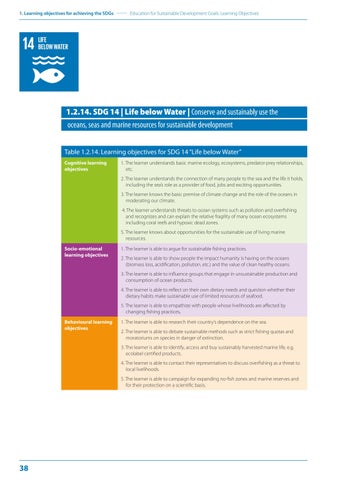1. Learning objectives for achieving the SDGs
Education for Sustainable Development Goals: Learning Objectives
1.2.14. SDG 14 | Life below Water | Conserve and sustainably use the oceans, seas and marine resources for sustainable development Table 1.2.14. Learning objectives for SDG 14 “Life below Water” Cognitive learning objectives
1. The learner understands basic marine ecology, ecosystems, predator-prey relationships, etc. 2. The learner understands the connection of many people to the sea and the life it holds, including the sea’s role as a provider of food, jobs and exciting opportunities. 3. The learner knows the basic premise of climate change and the role of the oceans in moderating our climate. 4. The learner understands threats to ocean systems such as pollution and overfishing and recognizes and can explain the relative fragility of many ocean ecosystems including coral reefs and hypoxic dead zones. 5. The learner knows about opportunities for the sustainable use of living marine resources.
Socio-emotional learning objectives
1. The learner is able to argue for sustainable fishing practices. 2. The learner is able to show people the impact humanity is having on the oceans (biomass loss, acidification, pollution, etc.) and the value of clean healthy oceans. 3. The learner is able to influence groups that engage in unsustainable production and consumption of ocean products. 4. The learner is able to reflect on their own dietary needs and question whether their dietary habits make sustainable use of limited resources of seafood. 5. The learner is able to empathize with people whose livelihoods are affected by changing fishing practices.
Behavioural learning objectives
1. The learner is able to research their country’s dependence on the sea. 2. The learner is able to debate sustainable methods such as strict fishing quotas and moratoriums on species in danger of extinction. 3. The learner is able to identify, access and buy sustainably harvested marine life, e.g. ecolabel certified products. 4. The learner is able to contact their representatives to discuss overfishing as a threat to local livelihoods. 5. The learner is able to campaign for expanding no-fish zones and marine reserves and for their protection on a scientific basis.
38


